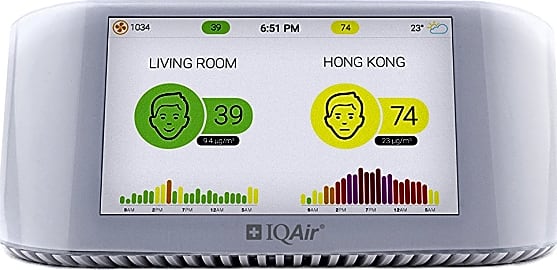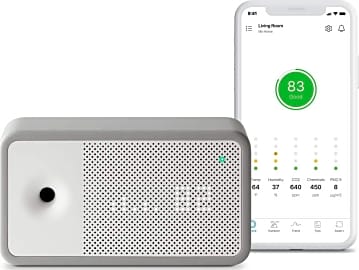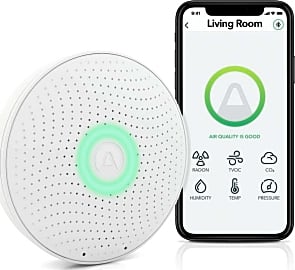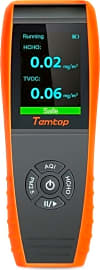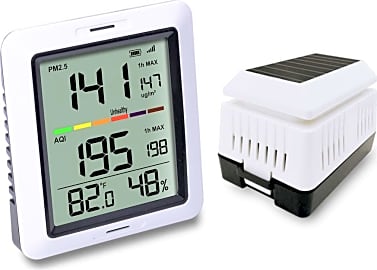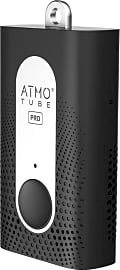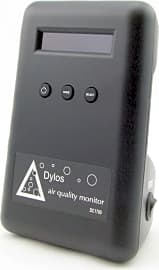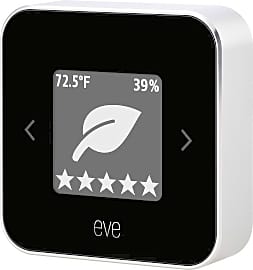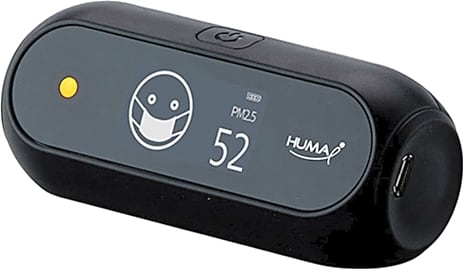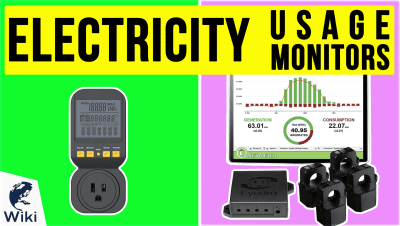The 10 Best Air Quality Monitors

This wiki has been updated 38 times since it was first published in August of 2015. If we watch what goes in our food and water, it makes sense that we should care about the air we breathe, especially with pollution and wildfires on the rise. These air quality monitors can measure volatile organic compounds, particulates, or CO2 levels, while some also display temperature and humidity. We've included a range of options for measuring your atmosphere at home or on the go. When users buy our independently chosen editorial recommendations, we may earn commissions to help fund the Wiki.
Editor's Notes
November 07, 2020:
With air pollution and wildfire seasons growing more severe every year, air quality is a growing concern for many. We've restructured our list around the air-quality measures that are most useful for most buyers, namely volatile organic compounds (gases and odors) and particulates (airborne matter). Some of our favorite models, like the Temtop M10 and IQAir AirVisual Pro, monitor both. Others focus on one or the other: the Ecowitt WH0290 measures particulates, while the Eve Room shows VOCs. We removed models that solely detect CO2, which poses fewer health risks, but included options like the Awair Element that measure CO2 along with other forms of pollution. Note that these models measure carbon dioxide, not carbon monoxide — most states require a dedicated monitor for that. The Airthings Wave Plus is unusual in that it also records radon levels, which may be a priority for homeowners. If you aren't sure which air quality measures you should be checking, we'd recommend sticking to PM2.5 (particulates) and VOCs. These monitors can only alert you to problems in your air — to fix them, you'll want to look at air purifiers and ventilation.
August 19, 2019:
A few upgrades shook up the list since our last ranking, most notably the new models by Temtop and Wynd. Wynd appears to have packaged their wearable filter along with a large, but still portable purifier. Temtop seems to have improved both the performance of both their display and their sensor, the latter of which takes after the more recognizably reliable sensors used by Extech and other industrial brands (though it still struggles somewhat to provide pinpoint accuracy). A new model at number two comes from a company called Breathe, and it's a low-profile, portable option with a big display and the ability to charge via USB-C. It even comes with an attractive docking station for use at home, and wouldn't look out of place next to the likes of an Amazon Echo or Google Assistant. The space for that opened up when we decided to lose one of the two Dylos models from our old list, since they were so similar in performance. We chose to keep the one that also offered portability with a 6-hour battery life, as opposed to the one that you have to plug in to use.
Special Honors
E-Instruments AQ Expert This industrial-grade device is a smart option for medical practices and other clinical office settings that might be exposed to more particulate compounds than the average household. It can test for 11 of these pollutants simultaneously, with real-time data logging and Bluetooth connectivity for sharing and additional storage. e-inst.com
PurpleAir PA-II Designed for use in industrial settings, this smart device has a lot to offer for homeowners. It's intended for use outside the home, where it becomes part of the brand's widespread monitoring network. It consistently performs to the standards of much more expensive equipment used by the likes of the EPA. purpleair.com
UHoo Air In addition to the usual pollution categories, this model is also capable of notifying you about dangerous levels of ozone and nitrogen dioxide. It's more expensive than many tabletop models, but it comes with Wi-Fi connectivity and an impressively detailed app. uhooair.com
Why Are Air Quality Monitors Important?
For these people, normal dust and pollen are also irritants that can cause big problems in their everyday lives.
While everyone can comprehend the idea that breathing air directly from a car's exhaust pipe is very bad for a person's health, understanding the overall air quality may be more important than ever imagined. A recent study found that children who grew up within 500 meters of a freeway have substantial deficits in their respiratory health which have lasted years.
Many studies show that exposure to freeway exhaust and simply the regional exposure to similar contaminants in the air have detrimental effects on the function of the lungs. Moving children away from these areas can help them improve their lung function and recover from any damage caused by exhaust pollutants, but in order to know that you need to do this, the number of contaminants and gases like CO2 must be measured and monitored. This is where an air quality monitor comes in handy.
These monitors are also very important in the houses of people with asthma and allergies. For these people, normal dust and pollen are also irritants that can cause big problems in their everyday lives. A monitor can tell them when it is time to clean the house to remove dust, or close the windows and turn on the air purifier in their home.
Most air quality monitors check for things like humidity, CO2 levels, and volatile organic compounds. It is important to understand the levels of these contaminants so users can know when it is time to take action. From re-painting the house with low-VOC paint to using certain indoor plants, users will know which actions to take when an air quality monitor can alert them to levels of certain contaminants that may be hazardous.
Air quality monitors also alert users to the presence of carbon monoxide. This is a poisonous gas which can make a person ill when they breathe it in, and can cause death if they are exposed to high levels of it. It has no smell or taste, so having a monitor around is the only way to know if it is present.
What To Look For In An Air Quality Monitor
Each region has their own set of safety standards for many different pollutants, such as carbon monoxide, lead, and sulfur dioxide. When looking for an air quality monitor, the EPA recommends looking for one which can accurately monitor as many of these contaminants as possible.
This helps one make an educated decision about what the next step should be toward safety.
Understanding what the monitor will be used for most will help the user to decide which one they should purchase. Some may alert the user only to contaminant levels, while others can be used to measure common issues people have with air quality, such as humidity levels, temperature, particle density, VOCs, and CO2.
For those who have kids or other loved ones at home while they are at work, the ability to remotely check on the status of the air in the house can be extremely beneficial. Very sensitive individuals who want to limit their exposure as much as possible to air pollutants that can cause them issues would also benefit from a monitor that allows them to check the status of the air in their home before ever setting foot inside. For these groups of people, a model with Wi-Fi capabilities is often a smart choice.
There is also the consideration of purchasing a fixed unit or a portable one. Fixed units are more geared towards office or home use and are often designed to be mounted in some manner, whereas mobile units will be better for professionals who need to test new areas regularly.
Some users may also need to know what different types of particles are in the air. For them, there are monitors which show the levels of both small and large particles, in addition to contaminant levels. This helps one make an educated decision about what the next step should be toward safety.
Simple Ways To Improve The Air Quality In The Home
While air purifiers and dehumidifiers are great to help adjust the air within an indoor environment, it is also necessary to take preventative measures to avoid contamination as much as possible.
The EPA recommends that you remove as much environmental tobacco smoke as possible. There are over 7,000 chemicals in tobacco smoke, which have been linked to respiratory disease, heart disease, and cancer. When smoke is in the air, it is obviously a big hazard, but the contaminants do not disappear when the smoking stops. The chemicals and pollutants in tobacco smoke settle on walls, furniture, and flooring, where they can still be made airborne, inhaled, and cause health problems. Completely eliminating smoking in or near the home is one way to greatly improve the air quality.
When the vacuum bag is full, it is also important to clean the bag outside.
Taking the time to do chores correctly can mean the difference between a safe breathing environment and a toxic breathing environment in the home. It is not well known that vacuuming quickly does little to remove the dust in the carpet, and in many cases it increases airborne contaminants. When vacuuming, make sure to pass the vacuum slowly and with care. This allows for the proper levels of suction to take away pet dander, pollen, dust, and other contaminants which become lodged in the carpet. It is best if one uses a HEPA vacuum, as well.
When the vacuum bag is full, it is also important to clean the bag outside. This is because pathogenic bacteria like E. coli can multiply very quickly within the vacuum bag, and opening it inside releases a cloud of bacteria into the air.
One of the simplest tips to improve the air quality in the home is to open the windows. This is especially important in the room of someone who is sick or in spaces the kitchen. Exchanging the air within a sick room can help to drastically reduce the number of bacteria floating around, as people who are sick often exhale the bacteria and viruses they are sick with. Cooking with the window open and the stove fan on can also help improve the air quality, as kitchen appliances like stoves and ovens can cause levels of nitrogen dioxide in the surrounding environment to spike. Researchers have found that home interventions such as these are effective at decreasing indoor concentrations of nitrogen dioxide.
It may also help to reduce the amount of fragrance used indoors. Fragrances are found in candles, laundry and dish soaps, perfumes, air fresheners, potpourris, and cleaners. Several studies have noted that nearly all top selling fragrance products emit toxic or hazardous substances like phthalates. It is best to choose soaps and cleaners free of perfumes when possible.


